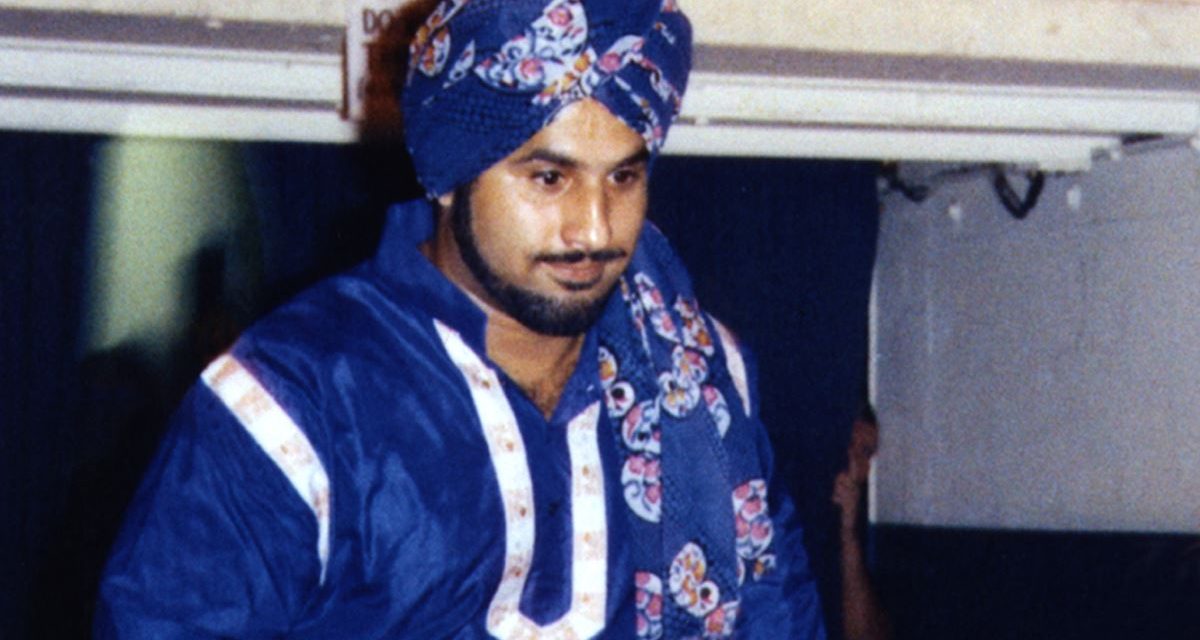When independent film producer Lalita Krishna decided to take on her latest production, the goal was to tell the story of a prominent Canadian of south Asian descent. As it turned out, she would in fact tell two stories in the independent film, Tiger!.
One is that of a gentle, wealthy grandfather, living in a luxurious home on a wide open estate in Milton, Ontario. The other is that of a sword wielding wild man who terrorized the professional wrestling rings of Japan. These two characters are in fact one man and his name is Tiger Jeet Singh.
“I had heard about Tiger Jeet Singh generally in the south Asian community,” recalled the Toronto-based Krishna in an interview with SLAM! Wrestling. “Not too many people had too many details about him. I wanted to follow up and figure it out because the story really intrigued me. Through a mutual friend I booked an appointment and went to his house to meet him.”

Tiger Jeet Singh now.
The man Krishna met was the opposite of the man who instigated near stampedes of terrified wrestling fans fleeing en masse, as the insane, turbaned Singh, with sword in hand, slashed his way to the ring. “When I went there, here was the gentleman who looks like a benign grandfather, sitting with grand children who are running around all over the house. He looked like he wouldn’t hurt a fly,” said Krishna, who first met Singh in October of 2003.
That tranquil scene turned into the sharpest of contrasts when Krishna came upon a room in the Singh household, adorned with wrestling posters. There, staring back at her was the mad, ultra violent Singh — a face that had struck fear into the hearts of opponents and fans.
“Looking at the posters on the wall, there was blood oozing. He’s wrestled every single name you could think of,” she said. “I was fascinated to know this schizophrenic, dual personality. As a documentary producer, I like to find human stories – something that’s universal and interesting to everyone.”
With the approval of Singh, Krishna would set off on a sojourn of discovery with her In Sync Video production company, and in doing so, would bridge the two personalities of Singh into film format.
In May 2004, Krishna began to follow Singh, exploring his everyday life with his family, with the goal of presenting an accurate portrait of who he truly is. “I wanted to show that for him, his background and who he is, is very much part of who he is. It’s not something he just puts on. This is very much his persona.”
Even before she began to delve into the world of Singh, Krishna soon found that among the members of the Indo-Canadian community, there was little insight into the true heights of success Singh had reached. “They know him as a successful business man. They know he was very successful in wrestling way back when. Very few people are aware how successful his career was between the ’70s to the year 2000.”
To understand this obliviousness, one must recognized that it was not on the shores of North America that Singh earned his iconic status, but in the land of the Rising Sun, Japan.
“It was very much a case of out of sight, out of mind. They were not hearing about him in the papers every day in Canada,” observed Krishna, adding that professional wrestling was not as well liked within Indo-Canadian circles. “Pro wrestling had not caught on in the Indo-Canadian community as maybe as it would today. In India, it’s very popular. It’s a case where young people are into wrestling now, but Tiger is not a part of that scene.”

Lalita Krishna
A former professor at Ryerson University, Krishna relied on a variety of sources to piece together the story of Singh, including the Canadian Broadcasting Corporation (CBC), wrestling historian and SLAM! Wrestling producer, Greg Oliver, and the Singh family. This process of verification was needed to filter the personal recollections given by Singh.
“When you talk to Tiger, for him, the years just roll one into the other and it was very hard trying to get the facts in terms of specific dates,” she said. “We had to go through a lot of information to get that. His wife is absolutely phenomenal in terms of keeping records. They’ve got a basement with ten cartons full of albums. She gave us a lot of photos of the early days.”
What soon began to evolve was more than a wrestling story. Like many newcomers, Singh arrived in Canada with little else than a few dollars and the hope of making something out of himself. From there, the Indian migrant would eventually don wrestling tights and set out to claim his own piece of the Canadian dream.
While the quest for fame and fortune started in buildings like the famed Maple Leaf Gardens of Toronto, it would be on the far off shores of Japan that Singh rose from being a mere wrestler, to a feared demi-God. With camera crew in tow, Krishna would set off with Singh to Japan in the October of 2004. There, Singh would enter the ring once more to do battle at 60 years of age. It would be the most critical part of his story for Krishna to document.
“Archival footage is good, but at 60 and you’re still wrestling, that is the story. That is what I needed to pin this entire thing on,” said Krishna. But she would get more than a simple wrestling match involving an elder statesman of the industry.
Krishna convinced Singh to journey out onto the streets of Tokyo to collect footage for the film. Unbeknownst to Krishna, Singh had also arranged for a local wrestling journalist to meet them at a local temple. What she would see first was a magnetism that still draws awe-struck crowds.
“We took two cabs and arrived at the temple,” recalled Krishna. “There was not one reporter; there were six reporters with flash cameras. Tiger got out of the taxi and they started swarming him. The word had spread that Tiger was going to be there. They started interviewing him and I was trying to say ‘No, no, he’s here for us. We need some shots of him walking.’
“Then my camera person said ‘No, no, this is great. Let’s get this.’ Then the crowds started coming in; young, old, people came there and said ‘Is that for real? Is that Tiger?'”
What Krishna failed to realize at first that what was happening was an anomaly, for Singh rarely made public appearances throughout his tenure as an evil gaijin (foreigner) wrestler. For the Japanese, even those who were not wrestling fans but knew of Singh from television and newspapers, this was an opportunity to be in the presence of greatness.
“I’m sure there were people there who didn’t know Tiger, but knew he was an important man because they were getting their picture taken with him,” laughed Krishna. “Then he took a walk down to this market and people were coming out of the stores and saying ‘Tiger, please come and eat my cake!’ Tiger would go in and eat their cake and say ‘Oh, this is very good.’ That was an endorsement for their product. Then everybody started coming out of their stores and giving him free stuff. This is something that would not happen if he walked down the street in Toronto.”
Surprised as she may be with the adulation Singh received in a simple street market, nothing could prepare her for what she would see first hand the day after, when Singh would wrestle against Naoya Ogawa for the Hustle promotion. It was there that she bore witness to the re-awakening of the tiger that had lane dormant within the confines of a calm, immigrant retiree.
“I had my own camera and I wanted to be by the door when Tiger comes out into the arena,” said Krishna. “People said, ‘Don’t stand there. He’ll come out with his sword and he’ll lash out at everything in sight.’ I said ‘I’m with Tiger, he knows me.’ And they said ‘At the time he comes out, he doesn’t know anybody.’ That’s what distinguishes Tiger from anything else. He is out and out his persona; he pumps himself. That’s why you have all of these people holding him back. He does not know you at that moment in that frenzy. In all of the close-ups, he is completely transformed.”
But what really gave away the coming madness that is Tiger Jeet Singh was the Japanese audience in attendance as Krishna recalled. “You could see the hush going through the audience. You could see that they knew something was going to happen. It’s the unpredictable part of Tiger is what keeps the audience coming back to him.”
Be assured, on this night, Singh lived up to his reputation.
Coming to the entrance way, the crazed Singh promptly stormed forth into the ringside seating, sword flailing and throwing chairs high into the air. Before him, a sea of terrified wrestling fans repeated what fans from years past had done before the charging Singh and ran for their lives.
He would soon turn his attention to his opponent, blood would flow and finally, Krishna found her tiger.
In watching this film, Canadian fans will no doubt come away feeling jealous of the Japanese and their special relationship with Singh. There will also be a sense of having been cheated, denied the privilege of having watched one of our own grow before us into the larger-than-life professional wrestling ego that he became.
“I hope people will watch the movie because it is a good story and will be entertained by it,” said Krishna, who previously had done a documentary on 2000 Canadian Olympic champion wrestler Daniel Igali. Tiger! has already won the Best Canadian Documentary award at the Reel World Film Festival held recently in Toronto.
“I think it’s an important part of Canadian wrestling history and that is an important reason for Canadian wrestling fans to watch it. They need to know that wrestlers are real people too.”
From there, it will be up to viewers to decide which Tiger they believe in the most.
The premiere broadcast of Tiger! can be seen on the OMNI 2 channel this Saturday, April 23 at 7 pm EST. OMNI 2 is avaiable on Starchoice on channel 343 and Bell ExpressVu on channel 217. Cable subscribers should contact their local cable provider for availability.
RELATED LINKS

